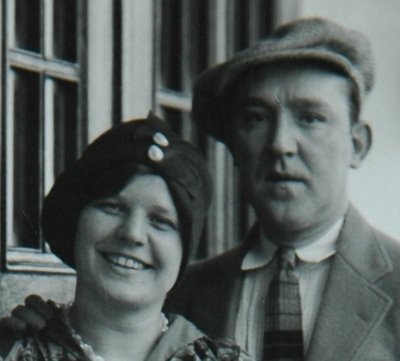Tudor ramblings
I popped into the National Portrait Gallery yesterday after a job interview in London. (I had stashed a change of clothes in the museum's cloakroom prior to my interview which was just down the street so that I could spend the rest of my day out in London NOT in heels and a wool suit.)
As its name suggests, the museum is devoted exclusively to portraits. The oldest works in its collection are of the Tudor family, begining in the 1400s and including some Hans Holbein works--exactly the kind of thing I'm a sucker for. Floor map in hand, I headed directly for the Tudor gallery.
* * *
Elderly British woman 1: Ahh, this one is Catherine of Aragon.
Elderly British woman 2 (hobbling over with two canes, stopping to adjust bifocals): Yes, she was married to Henry VIII. Their marriage was to form an alliance between England and Spain. Henry cast her aside when she got old so that he could marry a younger woman, Anne Boleyn. He didn't cut her head off, but I think she spent the rest of her days in seclusion, at a nunnery or some sort.
EBW 1 (studying portrait more closely): Hmm. Is that right?
EBW2: You know, I really admire her. It couldn't have been easy, giving him all those years only to be disposed of. She was a virtuous woman.
[thoughtful pause]
My, how pale she looked--and from sunny Spain. Not much sun for her here, was there?
EBW 1: Which one was she? Was she his third wife?
EBW2: I'm not sure. Let's read the card.
Young American woman (aka me): She was his first.
EBW2 (smiling): Ah, yes. I get them all confused.
* * *
I don't know if you appreciate how much restraint it took for me not to say more, with Tudor History Geek Thrill pulsing through me. I didn't want to intrude, but did they realize that Henry's maneuvering to rid himself of Catherine is one of history's most exciting stories with no shortage of sordid details and political intrigue?
Catherine was originally intended as a bride for Henry's older brother, Arthur. They married in 1501, but six months into the marriage Arthur died suddenly. When Henry assumed the throne several years later, he married Catherine (historians generally agree that they were in love).
Catherine maintained that her marriage to Arthur had never been consummated due to their tender age, and this paved the way for her union with Henry. But after 24 years of marriage, itching to move onto a younger woman who could give him an heir, Henry did an about face. He petitioned Rome for an annulment, claiming that Catherine had in fact slept with Arthur, cementing Henry and Catherine's status as brother and sister and making their marriage incestuous and therefore illegal. To prove his point, he dug up stories of 14 year old Arthur bragging about his "sleepovers" with 15 year old Catherine to members of court. (Can you imagine?)
But Catherine did not go quietly. She refused to be supplanted by some upstart tramp. And she was protecting her daughter, Mary (if her marriage proved to be illegal, then Mary would be a bastard with grim future prospects). Conveniently, Catherine's nephew, Charles V, was Holy Roman Emperor and pressured (an understatement) the Pope not to grant Henry's wishes.
Nor did Anne Boleyn give up easily. She had Henry wrapped around her little finger and manipulated him artfully. For one, she didn't sleep with him as all his other mistresses had (including, previously, Anne's own sister). Yes, there was heavy petting--in one love letter Henry refers to her breasts, longingly, as "pritty duckys I trust shortly to kysse"-- but she held out going all the way with him--seven years--until it was certain Henry intended to leave Catherine.
Henry eventually broke from Rome and formed the Church of England, with himself as the head, in order to get his way. Catherine was banished, and Anne Boleyn took her place (though not for long).
Anne was fiery, opinionated, and a fervent supporter of the Reformation. It is thought that it was she who influenced Henry to establish a Protestant church in England, and after their marriage was very politically influential. But her political nature was regarded as inappropriate for a Queen, and she made many enemies within Henry's inner circle. These same advisors eventually turned Henry against her, fabricating evidence that Anne was carrying on several affairs, including with her own brother. She was convicted of treason and beheaded at the Tower of London.
Henry did not stop his philandering after marrying Anne, and some historians feel her failure to give him a son, and his infatuation with a new found marital prospect (one of Anne's ladies in waiting), contributed to Henry's willingness to plot against her.
Either way, eleven days after Anne's execution, Henry married wife number three, Jane Seymour.
Probably best I didn't lay the "pritty duckys" on those women, huh?















